AMD's Phenom II X4 965 Black Edition
by Anand Lal Shimpi on August 13, 2009 12:00 AM EST- Posted in
- CPUs
PAR2 Multithreaded Archive Recovery Performance
Par2 is an application used for reconstructing downloaded archives. It can generate parity data from a given archive and later use it to recover the archive
Chuchusoft took the source code of par2cmdline 0.4 and parallelized it using Intel’s Threading Building Blocks 2.1. The result is a version of par2cmdline that can spawn multiple threads to repair par2 archives. For this test we took a 708MB archive, corrupted nearly 60MB of it, and used the multithreaded par2cmdline to recover it. The scores reported are the repair and recover time in seconds.
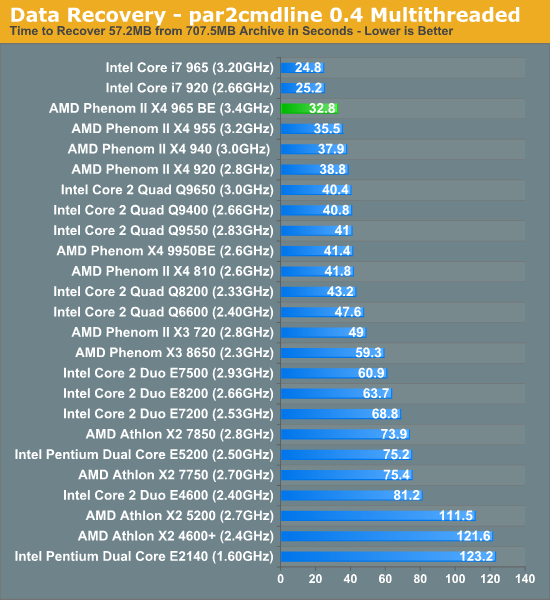
Microsoft Excel 2007
Excel can be a very powerful mathematical tool. In this benchmark we're running a Monte Carlo simulation on a very large spreadsheet of stock pricing data.
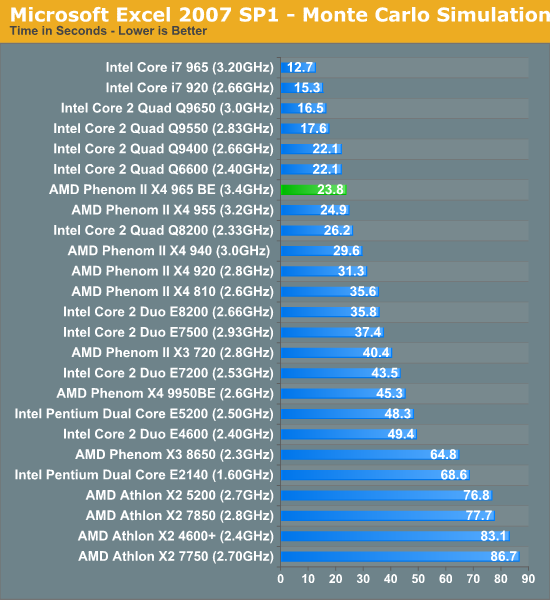
The same is true for our Excel Monte Carlo simulation - where there's an Intel optimization, the performance is predictable.
Sony Vegas Pro 8: Blu-ray Disc Creation
Although technically a test simulating the creation of a Blu-ray disc, the majority of the time in our Sony Vegas Pro benchmark is spend encoding the 25Mbps MPEG-2 video stream and not actually creating the Blu-ray disc itself.
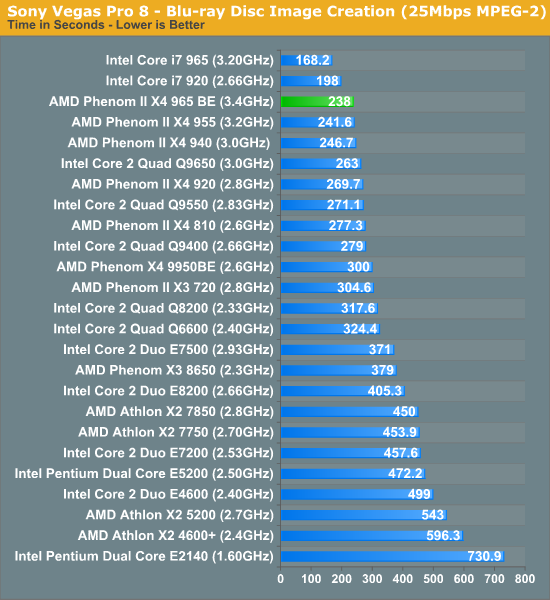
More of the same here - the 965 BE is faster than any LGA-775 Intel CPU here, but compared to i7 it's noticeably slower.
Sorenson Squeeze: FLV Creation
Another video related benchmark, we're using Sorenson Squeeze to convert regular videos into Flash videos for use on websites.
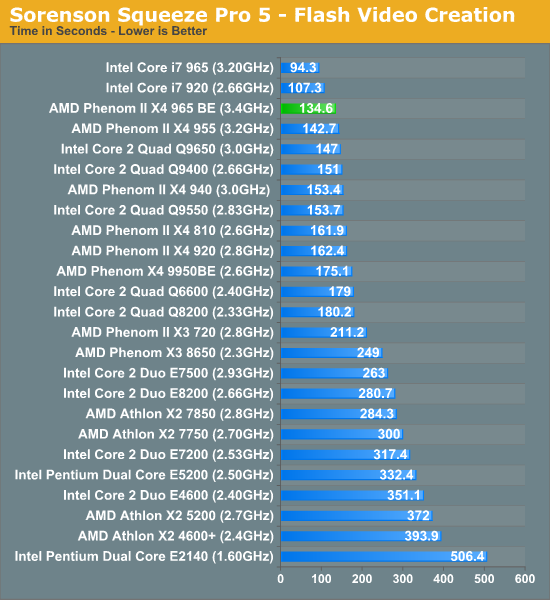
I'm running out of ways to say that the standings remain unchanged.
WinRAR - Archive Creation
Our WinRAR test simply takes 300MB of files and compresses them into a single RAR archive using the application's default settings. We're not doing anything exotic here, just looking at the impact of CPU performance on creating an archive:
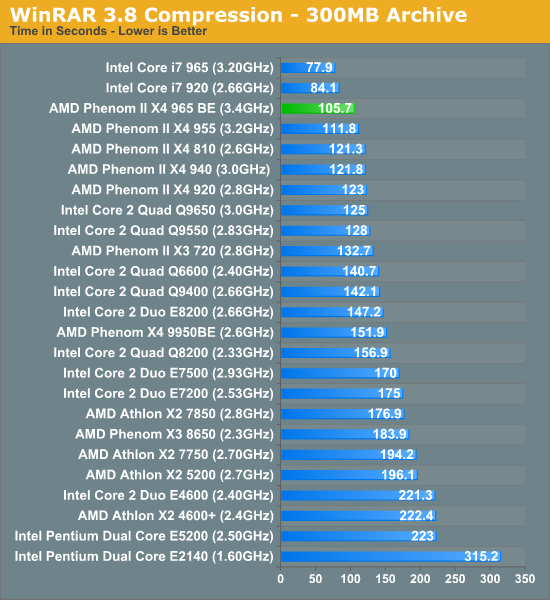
The standings remain unchanged.










54 Comments
View All Comments
Roland00 - Thursday, August 13, 2009 - link
The 200 dollar price isn't a mail in rebate, Micro Center a small computer store chain with about 30 stores market itself as a computer builder destination. They lose about 80 dollars on the processor to get you into the store and hoping to sell you enough other stuff (or assembly or warranties) to make up for their loss leader.steelicon - Thursday, August 13, 2009 - link
ROTFLMAOBBQ! Agreed! They get you in more ways than one, either it's the Processor itself, the Chipset, the DDR3 or all of them combined. Good thing we have another choice of platform!steelicon - Thursday, August 13, 2009 - link
Will this run on an old AsuS Crosshair NV590A-SLI motherboard? I surely do hope so...grimpr - Thursday, August 13, 2009 - link
A really fast CPU, some minor tweaks to the K10 architecture and AMD stays "current", but the TDP's are ridiculous, 140W!!, for non existing gods sake! at 95W TDP and at the same price they would be excellent purchases to Intels Lynnfields. Clearly they are positioned at gamers,a crowd long lost to AMD. For uses other than happy jerking at intel compiler optimized benchmarks and moronic SuperPi's with analyzing miniscule FPS differences at games, the AMD Phenom II 905E at 65W TDP is an excellent buy. Something about the 45nm SOI manufacturing of this chips from AMD makes us wonder...FireSnake - Thursday, August 13, 2009 - link
You really need to grow up with this 140W and take a very close look at the power consumption table ;)JimmiG - Thursday, August 13, 2009 - link
It's not like the 140W TDP happened by accident or took AMD by surprise. 120 - 140W has been the target TDP for high-end CPUs for a long time. At this targeted TDP, AMD found a 3.4 GHz chip could be produced with decent yields. Some thought, research and design goes into the launch of a new CPU even if it's just a 200 MHz clockspeed bump.Don't worry, we'll not see a 160W or 180W CPU any time soon since 140W is a sensible target. Modern heatpipe coolers, mobos and PSUs have no trouble with them.
If you think the difference between a 65W and a 140W CPU is too much, you must live in a very dark house or apartment since each light bulb consumes almost that entire difference.
PrinceGaz - Friday, August 14, 2009 - link
My lightbulbs consume between 12 and 20W of power each as I long since left behind inefficient incandescent bulbs.hyc - Thursday, August 13, 2009 - link
You guys are reading way too much into that 140W TDP spec. Look at the loaded power consumption results, the 965 is 223W vs 220W for the 955. So it's using a whopping 3W more than the 955, BFD.Griswold - Thursday, August 13, 2009 - link
Some people seem to miss the T for Thermal in that figure indeed.hyc - Thursday, August 13, 2009 - link
Ah, so which part of the Laws of Thermodynamics did you skip in school?You can't emit more power out (thermal or otherwise) than you took in.